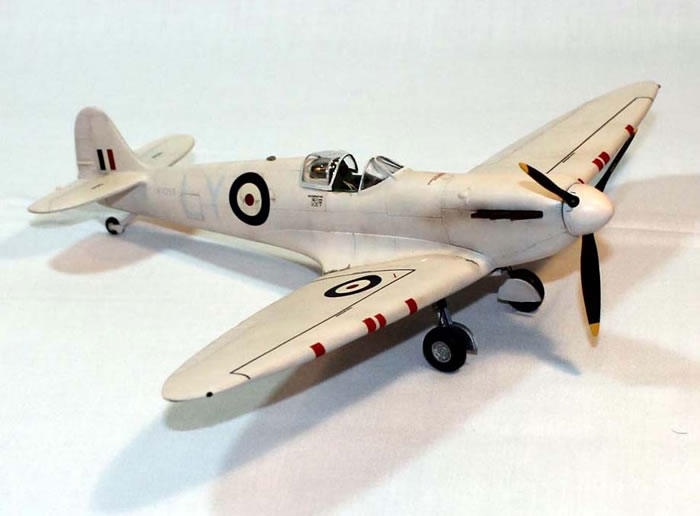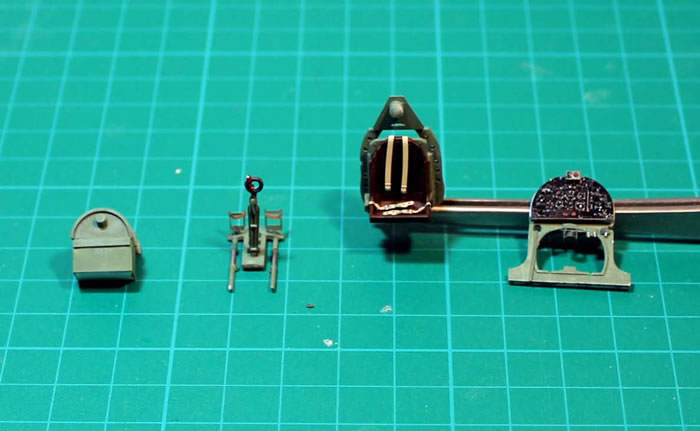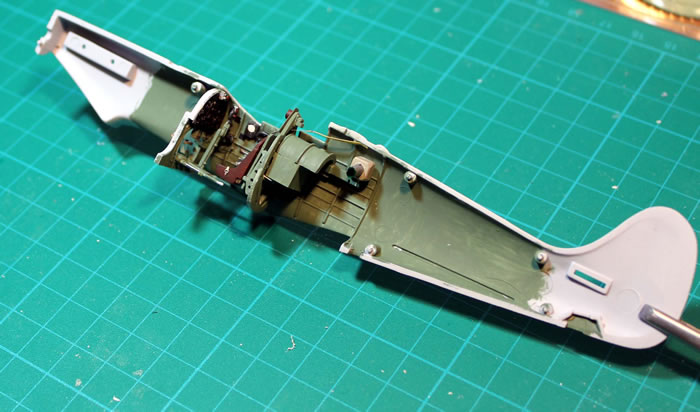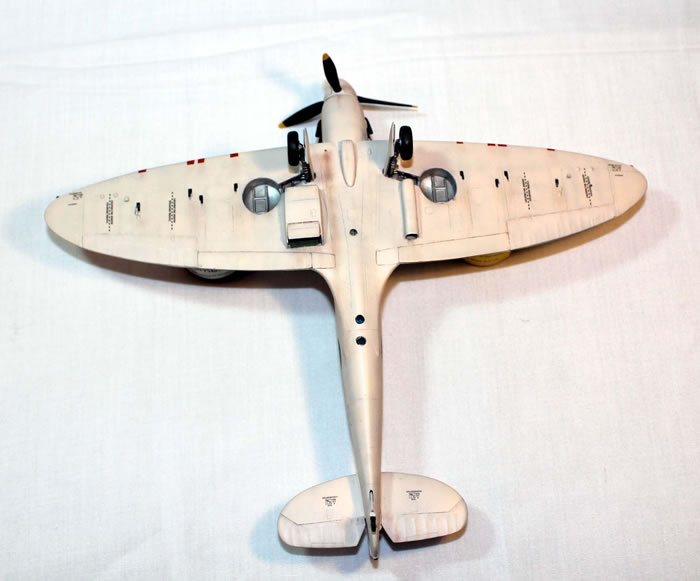Airfix 1/48 scale conversion
Spitfire PR.Mk.IG
by Fernando Rolandelli
|

|
Supermarine Spitfire PR.Mk.IV |

Airfix's 1/48 scale Spitfire Mk. I is available online from Squadron.com
Background
The need of taking pictures from below the clouds led to low level photo-recce variants of the Spitfire. Though fast, not being able to use height as concealment and a tactical advantage made low flying aircraft vulnerable to interception, so they kept the fighter’s armament and armour, including the armoured windscreen. The gunsight, however, was deleted for a simple reticule sight.
The variant was called PR.IG, later renamed PR.VII and later still a refurbished batch as PR.XIII. They had the 29 gal fuselage fuel tank to a total of 114 gal fuel capacity and 2000 miles of range. The camera equipment included three F.24 cameras: two verticals (5 in and 14 in lenses), one oblique. They operated in the 1st PRU, together to high altitude PR.1Cs, and later on in the Army Cooperation Command 1416 Flight and its successor, 140 Sqn.
Among their best known operations are the standing guard over the French ports and the missions over the Freya radar stations. Though armed, they had strict orders to avoid trouble (and would be chastised if doing otherwise, even successfully!), in fact being the sole judges on the chances of successfully finishing their missions. Even so, missions were considered so risky that they were called “dicing with death”; “dicer” was the name that eventually stuck.
The concept was carried on to later FR variants like the XVIII and to the Royal Navy Seafire FR.IIIs.
The Kit
In the search for a good, accurate 1/48 kit of the Spitfire, I decided to try the Airfix one (it is the one you can get at the Nairobi supermarket I use to walk around, anyway). This depicts the Mk.I/Ia/IIa classic BoB fighter. It must be said that, while a honest kit, it is barely acceptable in terms of finesse and details. Cockpit, especially, is awful.
I considered a resin set, but finally settled for an Eduard PE, which I first judged not enough, but in the end proved its worth, provided some scratch building is added. For the conversion to PR.IG, I would need to scratch build the cameras and more important, the rear fuselage fuel tank.
The PR canopy hood with its characteristic blisters came from an Aeroclub set. A few other details would be scratch built or sourced from somewhere else.
Cockpit Interior
The lack of finesse and detail of the cockpit interior is dumbfounding; it nearly makes me drop the entire project. Once you begin to work in it, it gets better surprisingly easily. I used all the pieces in the Eduard set, plus a lot of scratch built items, just to upgrade it. The seat/armour/bulkhead is particularly thick and devoid of detail; I replaced the oversized seat by a surplus Tamiya one; the backseat armour by a SH one; the head armour, molded into the bulkhead, I carefully sanded and replaced by a PE piece from Eduard’s Mk.V set. The bulkhead is a bit inaccurate, but it can pass. The PR specifics were added: the camera control replaced the gunsight, while another selector panel went into the left sidewall. The throttle also came from a Tamiya surplus piece.

After much pondering, I came to a way of reproducing the fuselage fuel tank. I took a half 50 gallons fuel drum from the Hasegawa German weapons set, and added a lower half made from a thick styrene strip, trying to mimic the excellent piece in the Pavla PR conversion set. It is not perfect, too rounded on top, but it pass muster. I glued it to lugs in the seat bulkhead, concealed behind the armour.

The camera bodies are all but invisible behind the fuel tank, but the lenses have to be made somehow. I opted for the well-tried clear rod (a piece of sprue) tucked into a hole in both wing and fuselage; when properly painted (dark “body” and Tamiya Clear Blue or Green “lens”) it is quite effective. The ports are on the centreline in the G, not staggered, that means that the rear one has to be drilled half in each fuselage half. I made half holes with a file, carefully aligning them; instead of drilling it once the fuselage halves were glued, risking their breakage. The oblique was another thing; I had decided to keep the hatch shut (nevertheless, I had to fill the one present and re-scribe it in the proper position and size); I took a landing light from an Academy Spitfire XIV (a kit which becomes most useful once you desist in building it!), drilled and glazed the port (later found a picture where the port is much bigger than the one I had made, but conversions are like that). But still the camera would be visible looking back through the headrest; I concocted a sort of cube shape (real ones were sometimes covered in a canvas heater bag) out of a resin carrier and a tubular “lens” and glued it to a frame attached to the back of the tank, more or less aligned to the port; it worked.
Fuselage
The exterior of the fuselage was further refined. To the re-scribing of the main camera hatch, I added the right side service hatches (and took the chance to fill and re-scribe the battery hatch), the small intake on the left cowling cheek (which I deem associated to the Merlin 45 conversion); the bulges on top of the cowling are missing (the small ones) or are ridiculously ill defined (the big one in the left, the one in the right is surprisingly good), so I scratch-built new ones. I also thinned down the fin and rudder.
The entry door shows the infamous “step” between its rear and the forward quarter light frame; I filled the panel and re-scribed it in its correct place, but that precluded opening it (I took the chance to eliminate the ridiculously oversized hinge). After that, fuselage was pretty finished and could be closed.
The exhausts were replaced by the Quickboost set, glued after painting; the moulded radio mast base and the position light (in solid grey plastic!) were sanded down and replaced, the former by a styrene oval shape and the latter by a bubble made of clear styrene.
The lower cowling, added after the wings are mated, stands almost a millimetre proud at the nose forward end. Just hack it down. When I looked for the fuel cap, I found none was provided! I made one with a styrene rod.
Transparencies: they are very clear and the windscreen a good fit (though not the rear window: it is too small and I think the spine is too square). Problem is that they are as thick as armour. I didn’t care about the rear window (latter regretted not having replaced it with a vac) and the hood, which would be replaced anyway; but something had to be done about the windscreen. Unfortunately, its size and shape (the very early “rounded sill” type) doesn’t allow for a generic vac form replacement. I bravely opted for sanding it from the inside and polishing; a final coat of Xtracrylix clear gloss varnish (no, “there is no Future in this country”) completed an acceptable look.
Wings
Not having to seal the gun ports and hatches meant the wings could be finished relatively quickly. I added the gun muzzles to the empty ports (only to cover them with putty afterwards, in preparation for the painting of the usual Red tape coverings), and the rear facing exhausts for the gun heating system to the outer wing panels. The separated flaps were expected to give trouble and they stood to their reputation; but they could be persuaded to fit; and once puttied and vigorously sanded they almost blended into the lower wing, re-scribing the hinge; nothing could be done to thin the trailing edge, however.
The radiator casing is not only inaccurate in shape (the mouth is far too big), but devoid of any detail as well; I would have replaced it had I got anything available; having none, I scribed the panel lines following the ones in the Tamiya kit, and thinned down the rear flap and mouth.
The radiator themselves have no detail in their front or back whatsoever; I took a fabric fancy strip which provided a web-like detail and glued it to a false front and back; I added the small pipes.
The oil cooler also looks very big and required thinning the lips down with a round file; the join line in the middle has to be filled from the inside, a troublesome task; the seam on the front and back themselves, impossible to fill and sand, I masked with small pieces of Tamiya tape cut to shape.
The step between the under surface piece and the wing tips –integral to the upper half- could be worse; some sanding levelled it.
Once everything was together, it was time to plan for the painting and decaling. Camouflage and insignia of PR Spits are a minefield, as the PRU was officially exempted from having to follow the usual practices; not in vain it was called “N° 2 Camouflage Unit” at a time!
You have to rely on photographs (pun intended) and there are many interpretations; moreover, there is always some “new” (i.e., previously not considered) material coming into light that destroys many of them (the PR.IAs are a perfect example of this… sometime in the future I shall tackle one of them).

“Dicers”, as low flying PR aircraft were called, were never painted Camotint (Sky) or PR Blue, but a most unusual off-white with a pinkish hue (there was another, darker and most intriguing scheme consisting of EDSG/EDSGreen over PR Mauve). I settled on R7059, a 1st PRU machine, which was detached to St. Eval for coverage of the Brest ports for most of 1941. It is depicted in the decals included in the Pavla U48-34 set, but I found a picture in Alfred Price’s “Spitfire, The Story”, showing they are less than good. Roundels are too big and there is the unit’s code, “LY”, at the rear fuselage (that could have been added or removed later, though). Therefore, I resorted to the decals in the Model Alliance 48-131 sheet, which, though intended for other machines, would be fine (in the picture I have seen, the Red roundel centres look a non-standard, bigger size); serial was Pavla’s.
Wing walks were SH’s; stencils and other marks came from the Airfix sheet. The “baby Pink” I made with White with a touch of Light Grey, and an even lighter one of Red (the slightest excess of the latter turns the colour into a totally unacceptable “Candy Crush Pink” shade); the White and the Red were Humbrol paints while the Grey was actually Xtracolour Light Aircraft Grey. I painted the Pink in very light coats over the Grey Primer with a heavy preshade, and kept it translucent for a dirty and battered look. I applied a wash on movable surfaces, and made a light pass on detachable panels with an “F” graphite 0,5 mechanical pencil, just to break the surface.
Decals were applied over a handbrushed Xtracrylix gloss varnish; the trick is using a flat soft brush, working in the direction of the airstream or downwards, always from panel line to border or the other way, and loading the brush with exactly the amount of varnish you will use. Never retouch until dry. Ah! Bubbles are your enemies. The flat clear coat was a mix of Xtracrylix Flat, an artist’s acrylic flattening agent and Xtracrylix thinner, properly airbrushed.
Is it a good kit? Well, in my opinion, barely.
It is incredibly chunky and under detailed.
It is fairly accurate in shape but not in the details. It also represents a very early machine with the “rounded” side panels in the windscreen (very soon replaced by straight panels; the “cheek plate” which can be seen in most pictures is surely added to cover the original rounded windscreen sill). The all-important cockpit door to the wings’ trailing edge alignment is not very positive; it doesn’t work unless you fix the “step” taking it back, but then the frame carrying the seat comes too forward…
The early machine the kit intends to depict, a non-armoured-windscreen one, should not have the cockpit armour installed, however it is designed integral to the frame. I also think the fuselage is a tad longer than it should (the distance between the tailplane and the rear fuselage panel line betrays this) and I guess at least the early machine depicted should have fire suppressors at the guns’ muzzles installed (a common criticism to the Tamiya kit, which shouldn’t!) It comes, however, with the correct lever to retract the undercarriage by hand (acquiring the notorious “Spitfire knuckles” in the process).
The radiator and oil cooler look too big, the undercarriage too chunky, trailing edges too thick, and there are some missing parts and details which prove very annoying.
It is one of those kits that built OOB will render a recognizable (in fact, quite accurate) representation of the aircraft, but it will look very toy like; on the other hand, improving that look even a little will require a quite involved and difficult work.
Reference Sources
-
“Merlin PR Spitfires, Classic Warbirds n° 10”, Wojtek Matusiak,Ventura Publications
-
“PR Spitfires on Worldwide Service”, On Target Profiles n° 8.
-
“The Supermarine Spitfire. A Comprehensive Guide for the Modeller. Part I: Merlin Powered”, Robert Humphreys, SAM Publications.
-
“Spitfire, the Story”, Alfred Price, Ian Allan Publications.
Images and Text Copyright ©
2013 by Fernando Rolandelli
Page Created 17 December, 2013
Last Updated
17 December, 2013
Back to
HyperScale Main Page

|
Home
| What's New |
Features |
Gallery |
Reviews |
Reference |
Forum |
Search